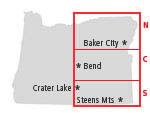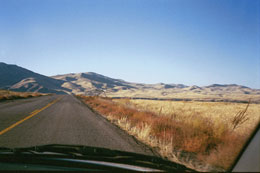







 |
 |
 |
 |
 |
 |
 |
 |
 
On the road |
The Road to Somewhere Else Umatilla You will most likely drive through Umatilla without thinking, unless you’re hungry and stop for a burger or a milkshake at the local drive-in. You won’t see the shallow Umatilla River with fishermen on every bank, and four-wheel drive pickups parked precariously on rocky outcroppings in the middle of the low-flowing water. Or see the tree-lined park, or the baseball diamond, the riverside trails, or the little wooden viewing hut perched at the water’s edge. You will see a line of stores, but mostly it seems there are For Sale signs, empty buildings, and a forlorn landscape, even though the Columbia River and a marina with a swimming beach, is just beyond the few buildings, railroad tracks and a stretch of Russian olive trees, willow and rushes. It’s likely you’ll speed on through and not even stop for a good prime rib dinner with real mashed potatoes. My inclination on the upper reaches of the Columbia, heading for
Walla Walla or Spokane has always been to drive on through too.
But one day in the autumn of 2001, my brother, sister-in-law
and I stopped in Umatilla. Most places were closed that day, but we did have the good fortune to meet Jim Garrison at his Oregon Trail Gallery & Trading Post and linger over impressive displays of Native American costumes, porcupine quill headdresses, dentalium necklaces, reed baskets, silver jewelry, art. Jim can tell you pretty much anything about regional tribes and their customs, culture and art. We admired photos and talked about Celilo Falls, and the Wasco County roundups and rodeos that we went to with our Uncle Bill as children. Jim had attended many of the roundups, and actually had stood on some of the rickety fish platforms that jutted out over the falls. Because we had limited time that, I headed back to Umatilla in May 2002. When I got to town, Richard’s store was closed and Jim wasn’t at his trading post. I think I’ll stay overnight in Umatilla, but am discouraged by a waitress who recommends that I go to a few miles inland to Hermiston to find a nice motel. Or the Desert River Inn, just down the highway at the golf course. The local motels do look a little dubious, so I head out to the golf course inn. It has nice rooms, but I don’t want to be cloistered in a courtyard-style place. I drive to Hermiston. The motels in Hermiston are nice, too, but why would I go to eastern Oregon and stay in some place that could be situated on the outskirts of Anyplace, USA? Dusty, forlorn tiny Umatilla is where I want to be. I drive back. I choose the Tillicum Inn because it’s on the Columbia side of the highway. Unfortunately, all riverside rooms are designated smoking, but the owner lets me walk in the empty rooms and decide which fragrant room I prefer. All the rooms are clean and have cable TV, a small fridge and a microwave too. My second-story room overlooks a parking lot and apartments in back, but I can see the river, bits of McNary Dam and best of all the rolling hills beyond and lots of sky. This is what I want. At nearly half the price of the others too. After breakfast at Bo Jac’s Landing where I have great hash browns, I walk down to Richard’s storefront, visit a while, and then go on to Jim’s. It’s open. The trading post has a faint scent of wood smoke. This is the lingering aroma of smoked hides stacked in the back room. I gravitate past the other artifacts to the moccasins in the glass case. They are tanned deer hide, hand-beaded and fringed. The sight of them brings a rush of happiness and loss. I know how delicious they feel. They are second skin. Every year, as kids, we would get new moccasins made from our dad’s deer hides. The deerskin moccasins were on our feet from Christmas until barefoot season. They were not worn in rain or morning dew, unless we borrowed dad’s, which had thicker soles. We knew the moccasins were things of beauty, but they were not for putting on a shelf. They were to be worn and we plum wore them out. Jim says the leather is so supple because it is tanned with brains. I wonder if my dad knew this. Did he deliver the brains with the hide? Jim tells me we were lucky to have those moccasins. Few people know how to skillfully handcraft moccasins anymore. And the art of brain tanning is nearly extinct. Jim supplies Native Americans from all over the region with hides for ceremonial dresses, moccasins, and drumheads. He mourns the rarity and feels the time is soon approaching when he can barely afford to do so. Richard, the refinishing carpenter, has the same lament. The old ways and the old items are disappearing. He’s had to diversify into reproduction items and antiques from China to stay afloat. I walk the sidewalks and wonder how long this town can last. There’s talk about sprucing things up and getting rid of the unsightly old crumbling buildings. Sure, it’s kinda shoddy, but at least it’s a piece of real eastern Oregon and not gussied up to look like a “Western” town. The pace is slow here. Kids still ride bikes down the back streets. Folks sit out in their yards and visit. Crowds gather at the baseball diamond. Evolution will come, like it’s happening everywhere – small towns disappearing, boarded up, or replaced with the facade of progress. How can a town like Umatilla survive without losing its past? It probably can’t. You might want to stop by while it’s still got its dusty heart. While people like Jim and Richard are still there. Before it becomes just Anyplace, USA on the road to somewhere else. Umatilla I-84 east approximately 200 miles to Hwy. 730. Update: Jim Carrico now owns the trading post. back to Northeastern Oregon overview
|